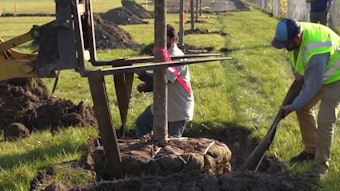Crabgrass is an annual weed that thrives in warm, wet weather. There are two types of Crabgrass, Smooth Crabgrass and Large Crabgrass.
Smooth Crabgrass can be identified as seedlings by small, smooth, light green leaves. It appears in the summer and can spread through the roots—and if left unmowed, it can reach about 6 inches in height.
Large Crabgrass can be identified by seedlings and light green 3-inch leaves that have a "hairy" appearance. It reaches maturity in the summer and can grow up to 2 feet tall. Large Crabgrass spreads through the roots and according to the University of California Agriculture and Natural Resource Department, one plant can generate around 150,000 seedlings.
Both types are low-growing weeds.
Smooth Crabgrass tends to be more prevalent in lawns than Large Crabgrass. Smooth Crabgrass responds to mowing and can still flourish after being mowed, whereas Large Crabgrass does not. Crabgrass first begins to germinate in the spring so early treatment is essential. Once the first frost in the fall hits, the crabgrass will die, but seeds will still be prevalent in the lawn and will return next summer if not treated.
Healthy, thick lawns are rarely affected by crabgrass because the turfgrass doesn’t allow for any of the seeds to germinate.
Prevention and Treatment
To prevent Crabgrass, keeping lawns well-maintained is the best defense. Mowing at a higher level means that even if there are seeds, they won’t be able to sprout. In-frequent watering can be another factor, so it’s best to do a deep watering every week.
The most effective way to treat Crabgrass is with a pre-emergence herbicide, which you apply in the spring before the seedlings have a chance to sprout. The most effective types are in the granular form and there are many different effective types including those that contain oxadiazon, trifuralin, bensulide or dithiopyr.
If the Crabgrass has already sprouted, post-emergent herbicides can be effective. To apply post-emergent herbicides, they can either be used by applying only to the visible crabgrass patches, or used along with a fertilizer just before the rain. Effective post-emergent herbicides contain dithiopyr, fluazifop and quinclorac. Depending on what type of grass is being treated, these can damage the turf, potentially.
Crabgrass can be pulled by hand, while this is only effective in treating visible plants, it does significantly reduce the amount of seeds that will germinate the next season. The entire plant must be removed, including all of the roots or new ones will sprout.
Get more information and find some products used to treat Crabgrass on our website.
Sources used:



























